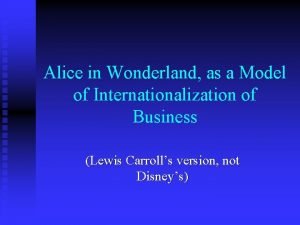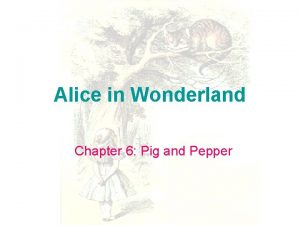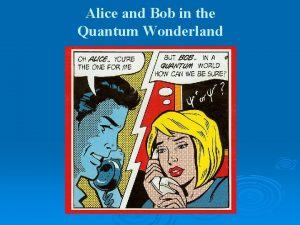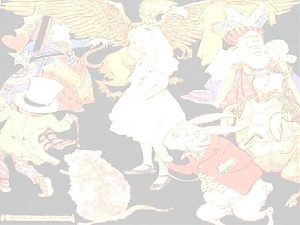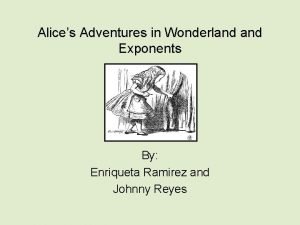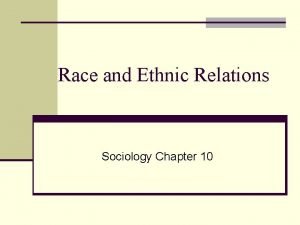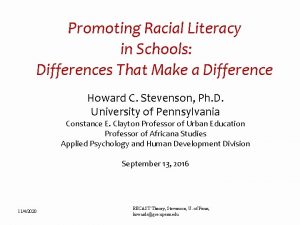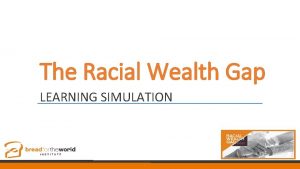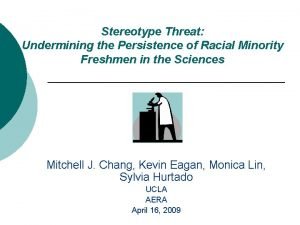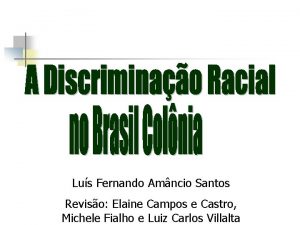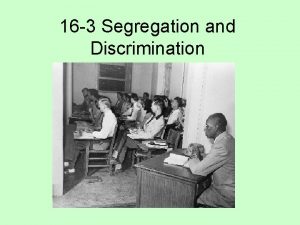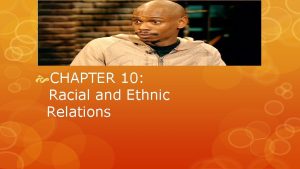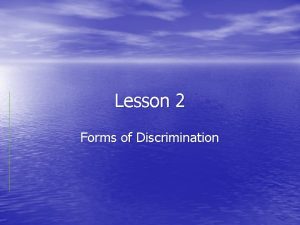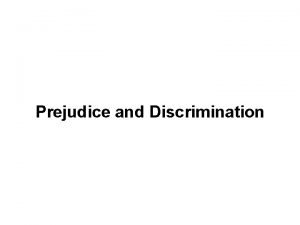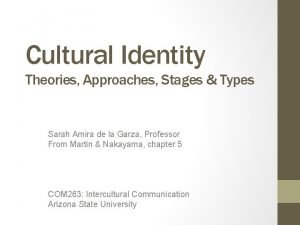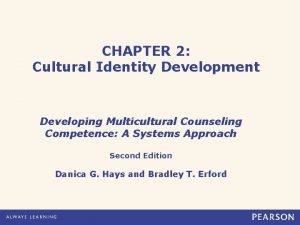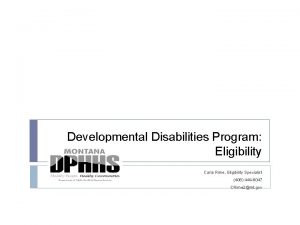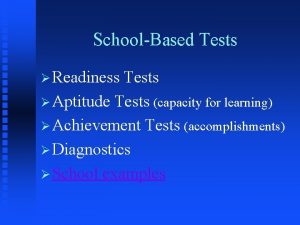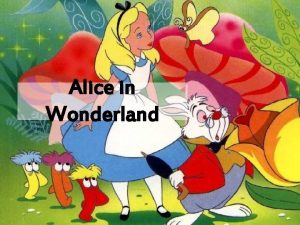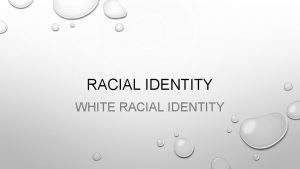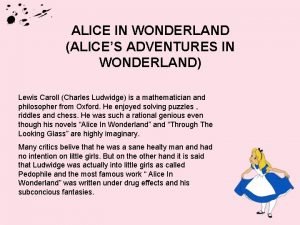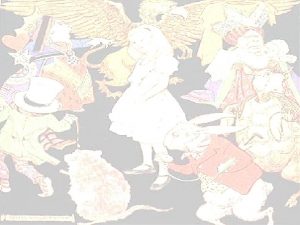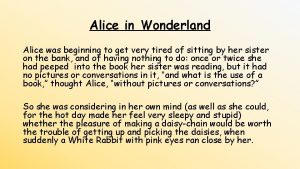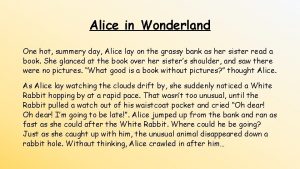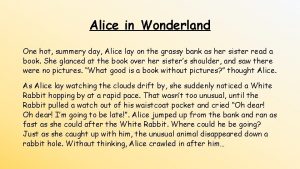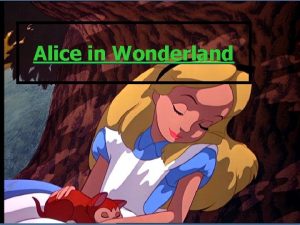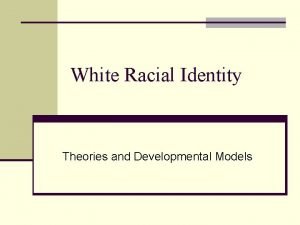Nonwhite Racial Identity Developmental Models Alice in Wonderland


































- Slides: 34

Non-white Racial Identity Developmental Models

Alice in Wonderland CHAPTER V: Advice from a Caterpillar The Caterpillar and Alice looked at each other for some time in silence: at last the Caterpillar took the hookah out of its mouth, and addressed her in a languid, sleepy voice. 'Who are YOU? ' said the Caterpillar. This was not an encouraging opening for a conversation. Alice replied, rather shyly, 'I-I hardly know, sir, just at present- at least I know who I WAS when I got up this morning, but I think I must have been changed several times since then. ' 'What do you mean by that? ' said the Caterpillar sternly. 'Explain yourself!' 'I can't explain MYSELF, I'm afraid, sir' said Alice, 'because I'm not myself, you see. ' 'I don't see, ' said the Caterpillar. 'I'm afraid I can't put it more clearly, ' Alice replied very politely, 'for I can't understand it myself to begin with; and being so many different sizes in a day is very confusing. ' 'It isn't, ' said the Caterpillar. 'Well, perhaps you haven't found it so yet, ' said Alice; 'but when you have to turn into a chrysalis-you will some day, you know-and then after that into a butterfly, I should think you'll feel it a little queer, won't you? ' 'Not a bit, ' said the Caterpillar. 'Well, perhaps your feelings may be different, ' said Alice; 'all I know is, it would feel very queer to ME. ' 'You!' said the Caterpillar contemptuously. 'Who are YOU? '

Identity Development (Erickson)

Individual Exercise Who are you? (Answer 5 times, beginning with the words “I am”) n n n I am I am __________ _____

Individual Exercise (feedback) Many ways to answer: 1. As a personal characteristic 2. As a relationship to someone else 3. As a professional/occupational role 4. As an ideology 5. As part of social identity groups

Identity Development (Marcia) n May be viewed from the perspective of four statuses n Statuses vary along two key areas (1) exploration and (2) commitment n The four statuses include: Diffused Status Individuals have neither explored nor committed to a particular identity meaning. Foreclosed Status Individuals firmly committed to an identity based on influential others (e. g. , parents) without engaging in exploration. Moratorium Status Individuals are actively exploring the meaning of their ethnic identities but have not reached a commitment to a specific definition. Achieved Status Individuals who have actively engaged in exploration and have committed to a specific definition of their ethnic identity.

Identity status categories (Marcia) COMMITMENT E X P L O R A T I O N Present Absent Present Identity Achievement Moratorium Absent Identity Foreclosure Identity Diffusion

Implications of Identity Approach n Has real-world utility for understanding differences across the lifespan: n Adolescents were more likely to be in moratorium and less likely to be achieved than college students and adults. n College student and adults were more likely to be in the achieved status. n Reveals interplay between identity development and racial awareness: n Achieved individuals considered race to be more important than diffused, foreclosed, and moratorium individuals. n Moratorium and foreclosed individuals were more likely to perceive race to be central to self-concepts than diffused individuals. n Moratorium or foreclosed individuals felt more positive about their racial group than diffused individuals.

Group Identity n Fills variety of needs n Identity n Social comparison (Social Identity Theory) n Relief from existential angst (Terror Management Theory)

Group Identity (cont. ) n Encouraged through initiation rituals n Usually constructive n Sometimes used to promote hate n Sometimes used as proof of commitment/loyalty An Israeli boy wearing a military vest throws a mock grenade during a traditional military weapon display to mark the 66 th anniversary of Israel’s “independence” at the occupied West Bank settlement of Efrat on 6 May 2014. Gali Tibbongali AFP Reuters: Palestinian boys dressed in uniforms of Palestinian security forces and holding plastic toy guns take part during a rally marking "Nakba" in the West Bank city of Nablus May 15, 2011. Palestinians on Sunday mark the "Nakba", or catastrophe, to commemorate the expulsion or fleeing of some 700, 000 Palestinians from their homes in the war that led to the founding of Israel in 1948.

Bidirectional Influences… n Group influences individual n modeling of attitudes/behaviors n instrumental conditioning… n group extremity shift (exercise) n Individual influences n leaders n non-conformists group

Two approaches to non-White racial identity n Mainstream-Minority approach n Multicultural approach

Mainstream-Minority approach n Society is assumed to consist of a dominant culture (the “mainstream”) and a number of subordinate groups n Racial identity is a developmental process in which individuals traverse from one stage to another as a result of experiences with either the mainstream culture (in the case of the minority groups) or with one or more of the minority groups (in the case of the white majority)

Multicultural approach n Society is thought to consist of a number of different cultural groups, in which no single group is dominant in all regions or in all social spheres and smaller groups are engaged in complex patterns of involvement and mutual influences with the larger groups n Racial/ethnic identity is seen as a combination of personal attitudes and experiences with both majority and minority groups.

Mainstream-Minority approach (cont. ) n Four factors influence strength of racial/ethnic identity n n Size Power Discrimination Appearance Copyright Arunas Juska, Ph. D. http: //core. ecu. edu/soci/juskaa/SOCI 2110/Lectures/Race/sld 007. htm

Social history of Black racial identity n Social history dominated by two competing processes n Deracination (attempt to erase “blackness”) n n Decreased collective awareness of issues pertaining to race/class Thought to increase acceptance into mainstream society Decreased probability of group mobilization Nigrescence (development of Black identity; French: to become black) n n Early attempts focused on stereotypical psychological profiles § Traditional Negroes (Booker T. Washington) § Agitators, Black Militants (W. E. B Du Bois, Black Panthers) In 1970 s, emphasis shifted to describing developmental processes

Double Consciousness “It is a peculiar sensation, this double consciousness, this sense of always looking at one’s self through the eyes of others, of measuring one’s soul by the tape of the world that looks on in amused contempt and pity. One ever feels his twoness, -- an American, a Negro; two souls, two thoughts two unreconciled strivings; two warring ideals in one dark body, whose dogged strength alone keeps it from being torn asunder. ” (W. E. B. Du Bois, Souls of Black Folks, 1903)

Black racial identity development model (Cross, 1971; 1991) n Stage 1 (Pre-encounter): Person identifies with White people and culture and rejects or devalues Black people and culture (may be diffused or foreclosed) n Stage 2 (Encounter): Characterized by an emotional personal experience, which fosters need to change (most likely moratorium) n Stage 3 (Immersion-Emersion): Person completely identifies with Blacks, idealizes Black culture, and abhors all things White (may be moratorium or achieved) n Stage 4 (Internalization): Person overcomes defensiveness, idealization, and psychological effects of racism and develops a positive and secure Black identity (most likely achieved) n Stage 5 (Commitment): Person maintains Black identity while resisting the various forms of social oppression (most likely achieved)

Racial Identity: The Case of Malcolm X n Stage 1 (Pre-encounter) Person identifies with White people and culture and rejects or devalues Black people and culture n Stage 2 (Encounter) Characterized by an emotional personal experience, which fosters need to change

Racial Identity: The Case of Malcolm X n Stage 3 (Immersion-Emersion) Person completely identifies with Blacks, idealizes Black culture, and abhors all things White n Stage 4 (Internalization) Person overcomes defensiveness, idealization, and psychological effects of racism and develops a positive and secure Black identity n Stage 5 (Commitment) Person maintains Black identity while resisting the various forms of social oppression

Measuring Racial Identity (Helms & Parham, 1984) n Preencounter n 31: I feel that black people do not have as much to be proud of as white people do. n 08: I believe that white people look and express themselves better than blacks. n 40: Sometimes, I wish I belonged to the white race. n Encounter n 3: I am increasing my involvement in Black activities because I don’t feel comfortable in White environments n 19: I am changing my style of life to fit my new beliefs about Black people n 44. I can’t feel comfortable with either Black people or White people n Immersion/Emersion n 34: White people can't be trusted. n 18: I believe that the world should be interpreted from a black perspective. n 23: When I am with people I trust, I often find myself referring to Whites as “honkies, ” “devils, ” “pigs”, “white boys” and so forth n Internalization/Commitment n n 06: I involve myself in causes that will help all oppressed people. 16: I involve myself in social action and political groups even if there are no other blacks involved.

Black racial identity development model Cross Racial Identity Scale (CRIS) Vandiver et al. , 2002 n Pre-Encounter Assimilation: Racial group membership is minimized in favor of identity as an American and an individual. Malcolm X n Pre-Encounter Miseducation: Internalizes negative or stereotypical portrayals of Black people. n Pre-Encounter (Racial) Self- Hatred: Experiences profound negative feelings and selfloathing because he or she is Black. John Howard Griffin

Black racial identity development model Cross Racial Identity Scale (CRIS) Vandiver et al. , 2002 n Immersion-Emersion Anti-White: Persons who are consumed by hatred of White people and White society and will engage Black problems and Black culture but is unpredictable. n Immersion-Emersion Intense Black Involvement: Hold simplistic and romantic beliefs about Black culture and has an either/or mentality about complex issues.

Black racial identity development model Cross Racial Identity Scale (CRIS) Vandiver et al. , 2002 n Internalization Nationalistic: Stresses an Afrocentric perspective and engages Black problems and Black culture. (Internalization Afrocentric) n Internalization Biculturalist: Gives equal importance to “Americanness” and Africanness (e. g. , the comfortable fusion of White and Black cultures). Persons engage in aspects of mainstream culture and still maintains dedication to Black culture. n Internalization Multiculturalist: Identity spans three or more social categories or frames of reference. Persons feel and are a part of Black culture he or she easily appreciates a wide range of cultural events and activities.

Racial/Cultural Identity Development Model (Sue & Sue, 1990) n Stage 1 (Conformity): Unequivocal preference for dominant cultural values over their own. n Stage 2 (Dissonance): Differential experiences challenge his/her self‑concept. Denial begins to break down = questioning of the beliefs of the conformity stage. n Stage 3 (Resistance & Immersion): Complete endorsement of minority‑held views, rejection of dominant values of society. Desire to eliminate oppression, considerable guilt & shame that "sold out" his/her own cultural group and/or were involved in oppression. n Stage 4 (Introspection): Dissatisfaction with rigid group views which may be in conflict with their individual views. n Stage 5 (Integrative Awareness): Belief that there acceptable & unacceptable aspects of ALL cultures, but person should determine for themselves what is desirable.

Stage 1: Pre-encounter/conformity Cross (1971, 1991) Sue & Sue (1990) Attitude towards self towards other members of the same minority group Attitude towards members of other minority groups Attitude towards the dominant group likes self but race not salient or hates black part of self discriminatory groupappreciating group disinterest or group deprecating likes self but grouphates ethnic deprecating part of self

Stage 2: Encounter/Dissonance Cross (1971, 1991) Sue & Sue (1990) Attitude towards self Attitude towards other members of the same minority group Attitude towards members of other minority groups Attitude towards the dominant group anxious, guilty, angry confused angry, resentful conflict between selfdeprecating & appreciating conflict between groupdeprecating & groupappreciating conflict between dominant-held views & feelings of shared experience conflict between groupappreciating & groupdeprecating

Stage 3: Introspection/Immersion & Emersion Cross (1971, 1991) Sue & Sue (1990) Attitude towards self towards other members of the same minority group Attitude towards members of other minority groups Attitude towards the dominant group likes self, but primarily the black part of self idealization of all things Black but also a “blacker-thanthou” attitude disinterest uncontrolled rage, hate, prejudice concern with the basis of selfappreciation concern with the nature of unequivocal appreciation concern with ethnocentric basis for judging others concern with basis of groupdeprecation

Stage 4: Resistance and Immersion/Internalization Cross (1971, 1991) Sue & Sue (1990) Attitude towards self Attitude towards other members of the same minority group Attitude towards members of other minority groups Attitude towards the dominant group selfappreciating groupappreciating varies from Black nationalism to multiculturalism selective appreciation, controlled anger at oppressive systems selfappreciating groupappreciating conflict between feelings of empathy & feelings of culturocentrism groupdeprecating

Stage 5: Integrative Awareness Cross (1971, 1991) Sue & Sue (1990) Attitude towards self Attitude towards other members of the same minority group Attitude towards members of other minority groups Attitude towards the dominant group selfappreciating groupappreciating varies from Black nationalism to multiculturalism Same as stage 4 but with commitment to Black community and/or racial justice selfappreciating groupappreciating selective appreciation

Demographic Differences • Gender Men theorized to have a harder time embracing identity change (Munford, 1994) but could not find empirical data • Class Higher income associated with higher pre-encounter scores and less internalization (Parham and Williams, 1993) • Education (no significant relationship)

Limitations of Mainstream-Minority Approaches n Too linear n Over-generalized to broad range of Black individuals n No ideological alternative to US ideologies and world-view n Over-focused on the experience of oppression

The Multidimensional Model of Racial Identity (MMRI) Racial Identity Racial Salience Racial Centrality Racial Regard Racial Ideology “The extent to which one’s race is a relevant part of one’s self-concept at a particular moment or in particular situation” “In general, being Black is an important part of my self image. ” “A person’s affective and evaluative judgment of his or her race. ” “The individual’s beliefs, opinions, and attitudes with respect to the way he or she feels that the members of the race should act. ” Public “Overall, Blacks are considered good by others. ” Nationalist “Blacks and Whites can never live in true harmony because of racial differences. ” Oppressed Minority Private “I feel good about Black people” “The same forces which have led to the oppression of Blacks have also led to the oppression of other groups. ” Assimilation “Blacks should try to work within the system to achieve their political and economic goals. ” Humanist “Blacks and Whites have more commonalities than differences. ” Sellers, R. M. , Shelton, J. N. , Cooke, D. Y. , Chavous, T. M. , Rowley, S. A. J. , & Smith, M. A. A Multidimensional Model of Racial Identity: Assumptions, Findings, and Future Directions. African American Identity Development , 275 -299

The Multidimensional Model of Racial Identity (MMRI) Racial Ideology “The individual’s beliefs, opinions, and attitudes with respect to the way he or she feels that the members of the Race should act. ” Nationalist • Emphasizes the uniqueness of the Black experience • Believes that Blacks should be in control of their own destinies with minimal input from other groups (Self-determination) • Believes that Blacks should work and/or socialize together in order to promote the advancement of the race (Preference for African American social environments) Oppressed Minority • Emphasizes the commonalities of Experience between African Americans And other oppressed groups • More likely to view coalition building as the most appropriate strategy for Social change • Equally interested in the culture of other minority groups as they are in their own Assimilationist Humanist • Emphasizes the commonalities of all humans African Americans and the rest of American society • Believes in working within mainstream structures to change these systems and achieve life goals • Stresses the importance of social interaction between Blacks and Whites • Believes people should be viewed as Individuals, not representatives of their race • May hold strong beliefs in a larger force that impacts the destiny of all people • Less likely to define themselves in terms of race; likely to exhibit low levels of racial centrality Sellers, R. M. , Shelton, J. N. , Cooke, D. Y. , Chavous, T. M. , Rowley, S. A. J. , & Smith, M. A. A Multidimensional Model of Racial Identity: Assumptions, Findings, and Future Directions. African American Identity Development , 275 -299
 Alliteration in alice in wonderland
Alliteration in alice in wonderland Duchess in alice in wonderland
Duchess in alice in wonderland Alice in wonderland model
Alice in wonderland model Alice in wonderland plot structure
Alice in wonderland plot structure Pig and pepper alice in wonderland
Pig and pepper alice in wonderland Alice and bob in wonderland
Alice and bob in wonderland Math in alice in wonderland
Math in alice in wonderland Lizard alice in wonderland
Lizard alice in wonderland Alice's adventures in wonderland blurb
Alice's adventures in wonderland blurb Alice in wonderland chapter 2
Alice in wonderland chapter 2 Black studies and the racial mountain
Black studies and the racial mountain Drawing don tiburcio noli me tangere
Drawing don tiburcio noli me tangere Racial etiquette region
Racial etiquette region Chapter 10 racial and ethnic relations review worksheet
Chapter 10 racial and ethnic relations review worksheet Promoting racial literacy in schools
Promoting racial literacy in schools Racial wealth gap simulation
Racial wealth gap simulation Racial insults
Racial insults Chapter 10 racial and ethnic relations
Chapter 10 racial and ethnic relations Democracia racial
Democracia racial Racial theories apush
Racial theories apush Chapter 16 section 3 segregation and discrimination
Chapter 16 section 3 segregation and discrimination Chapter 10 racial and ethnic relations
Chapter 10 racial and ethnic relations Lesson 2 discrimination
Lesson 2 discrimination Racial prejudice
Racial prejudice Cartel ley organica contra la discriminacion racial
Cartel ley organica contra la discriminacion racial Social identity mapping
Social identity mapping Cultural identity development models
Cultural identity development models Cultural identity development models
Cultural identity development models Ruiz's chicano/latino ethnic identity model
Ruiz's chicano/latino ethnic identity model Difference between model and semi modal
Difference between model and semi modal Hardboiled wonderland
Hardboiled wonderland Mitosis in a winter wonderland
Mitosis in a winter wonderland Montana developmental disabilities program
Montana developmental disabilities program Sackler institute for developmental psychobiology
Sackler institute for developmental psychobiology Gesell developmental checklist
Gesell developmental checklist


